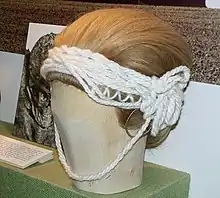
The Skrydstrup Woman was unearthed from a tumulus in southern Jutland in Denmark in 1935. As of 2017 carbon-14 dating showed that she had died between 1382 and 1129 BCE;[1] examination also revealed that she was around 18–19 years old at the time of death, and that she had been buried in the summertime.
Excavation of burial mound

Museum Sønderjylland's manager Christian M. Lund was responsible for the excavation of the burial mound. It was found 1 kilometre (0.62 mi) southwest of Vojens. The mound was on a bed of stone and covered with turf. It measured 13 meters (43 ft) in diameter and 1.75 meters (5.7 ft) high. Two men had been later placed in similar coffins at the edge of the burial mound. The mound was covered by a larger turf mound 24 meters (79 ft) in diameter and 4 meters (13 ft) high. The carbon 14 dating to around 1300 BCE is contemporaneous with a house plot on the Bronze Age farm in Skrydstrup 700 meters (2,300 ft) northeast of the mound, which may have been her residence.[2]
Appearance

She was buried in a short-sleeved woolen linen blouse with embroidery on the sleeves and neckline. A large square cloth of wool, gathered at the top with a belt, covered her from the waist to the feet. Attached to the belt was an ornate horn comb. The clothes were made of wool from a dark, reddish-brown sheep. The only jewelry was her large spiral earrings of 24 karat gold, which along with the blouse indicated she was of higher class.[3] Her ash blonde hair was about 60 centimetres (24 in) long and held in a complex hairstyle. Covering the hair was a fine hair net of unbraided horse hair made with the sprang technique, which was attached to an almost 5 meters (16 ft) long woolen cord at the front and back. The string was wrapped several times around the head so that it sat like a headband and held the hairstyle and hairnet securely in place.
Professor Karin Frei from the National Museum of Denmark described her as an elegant, queen-like figure.[4]
Origin and life
A study published in 2019 found that the Skrydstrup Woman was most likely from well beyond the modern borders of Denmark.[5] Research from 2017 had suggested that she could have come from the Czech Republic, southern Germany, France or Sweden.[4] She probably moved to Scandinavia from her original home when she was about 13 or 14.[1]
See also
References
- 1 2 Frei, Karin Margarita; et al. (2017). "A matter of months: High precision migration chronology of a Bronze Age female". PLOS ONE. 12 (6): e0178834. Bibcode:2017PLoSO..1278834F. doi:10.1371/journal.pone.0178834. PMC 5459461. PMID 28582402. e0178834.
- ↑ "Skrydstrup-pigen". Graenseforeningen.
- ↑ Kaul, Flemming. "Skrydstrup, We know where she lived – 1001 Stories of Denmark". Kulturarv.dk. Retrieved 11 November 2013.
- 1 2 Charlotte Price Persson (10 April 2017). "Another female Bronze Age icon is now known to have travelled across Europe". Science Nordic.
- ↑ "New study confirms that Egtved girl and Skrydstrup woman were most likely from afar". University of Copenhagen. 4 December 2019.
Bibliography
- Broholm, H.C.; M Hald (1939). Skrydstrupfundet. København: Nordisk Forlag.
- Broholm, H.C.; M Hald (1940). Costumes of the Bronze Age in Denmark. Copenhagen and London.
{{cite book}}: CS1 maint: location missing publisher (link) - Aner, E.; K. Kersten (1984). Die Funde der älteren Bronzezeit des nordischen Kreises in Danemark, Schleswig-Holstein und Niedersachsen, Nordslesvig – Nord, Haderslev Amt. Vol. 7. Neumünster: Wachholtz Verlag.
- Jensen, J. (1998). Manden i Kisten. Hvad bronzealderens gravhøje gemte. Gyldendal.
{{cite book}}: CS1 maint: location missing publisher (link) - Kaul, F. (1998). Ships on Bronzes: A Study in Bronze Age Religion and Iconography. Vol. 3. Copenhagen: National Museum of Demnark.
- Ethelberg, P. (2000). Bronzealderen. In Det sønderjyske landbrugs historie. Sten- og Bronzealder. Haderslev: Historiske Samfund for Sønderjylland.
- Jensen, J. (2002). Bronzealder 2.000-500 f.Kr. Vol. 2. København: Gylndendalske Boghandel.
- Kaul, F. (2004). Bronzealderens religion: studier af den nordsike bronzealders ikonografi. Det Kongelige Nordsike Oldskriftselskab.
- Frei, Karin Margarita; et al. (2015). "Tracing the dynamic life story of a Bronze Age Female". Scientific Reports. 5: 10431. Bibcode:2015NatSR...510431M. doi:10.1038/srep10431. PMC 4440039. PMID 25994525. 10431.
- Knipper, Corina; et al. (2017). "Female exogamy and gene pool diversification at the transition from the Final Neolithic to the Early Bronze Age in central Europe". Proceedings of the National Academy of Sciences. 114 (38): 10083. Bibcode:2017PNAS..11410083K. doi:10.1073/pnas.1706355114. PMC 5617280. PMID 28874531.
- Reiter, Samantha S.; Frein, Karin M. Frei (2019). "Interpreting Past Human Mobility Patterns: A Model". European Journal of Archaeology. 22 (4): 454–469. doi:10.1017/eaa.2019.35. S2CID 198644355.
- Thomsen, Erik; Andreasen, Rasmus (2019). "Agricultural lime disturbs natural strontium isotope variations: Implications for provenance and migration studies". ScienceAdvances. 5 (3): eaav8083. Bibcode:2019SciA....5.8083T. doi:10.1126/sciadv.aav8083. PMC 6415960. PMID 30891501. eaav808.
- Frei, R.; Frei, K. M.; Jessen, S. (2020). "Shallow retardation of the strontium isotope signal of agricultural liming - implications for isoscapes used in provenance studies". Science of the Total Environment. 706. Bibcode:2020ScTEn.706m5710F. doi:10.1016/j.scitotenv.2019.135710. PMID 31787292. S2CID 208535341. 135710.
- Frei, R.; Frank, Anja B.; Frein, Karin M. (2022). "The proper choice of proxies for relevant strontium isotope baselines used for provenance and mobility studies in glaciated terranes – Important messages from Denmark". Science of the Total Environment. 821. Bibcode:2022ScTEn.821o3394F. doi:10.1016/j.scitotenv.2022.153394. PMID 35093367. S2CID 246418942.
- Price, T. Douglas (2021). "Problems with strontium isotopic proveniencing in Denmark?". Danish Journal of Archaeology. 10: 1–12. doi:10.7146/dja.v10i0.121659. S2CID 240305680.